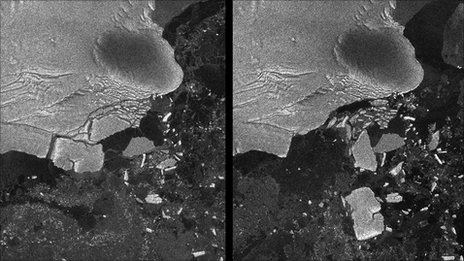Japan tsunami battered ice shelf in Antarctic
- Published

Images captured by Envisat on 12 (l) and the 16 (r) of March show ice breaking off into the sea
The tsunami caused by the 11 March Tohoku earthquake in Japan crossed the Pacific and broke off large chunks of ice from Antarctica, a study has shown.
Satellite photos show huge icebergs were created when the tsunami hit West Antarctica's Sulzberger Ice Shelf.
This caused 125 sq km of ice to break off - or calve - from a shelf front that has remained stable for the past 46 years.
The work, by a US team, is published in the Journal of Glaciology, external.
The waves generated by the 9.0 Magnitude earthquake in Japan travelled about 13,000km across the Pacific Ocean before reaching the Sulzenberger Ice Shelf, causing ice to break off and float into the sea.
The largest of the icebergs measured 6.5km by 9.5km, (almost the size of Manhattan) and 80m in thickness.
The swell was estimated to have been just 30cm high when it reached the Sulzberger shelf. But the researchers say that over a period of hours to days, the dispersed waves caused repeated flexing of the ice, "fatiguing" the shelf and causing it to fracture.
Kelly Brunt from Nasa's Goddard Space Flight Center in Maryland, US, and colleagues studied a series of synthetic aperture radar images from the European Space Agency's Envisat satellite taken between 11 and the 13 March. This allowed the team to constrain the calving event to a period consistent with the arrival of the tsunami.
"The impact of the tsunami and its train of following dispersed waves... in combination with the ice-shelf and sea-ice conditions provided the fracture mechanism needed to trigger the first calving event from the ice shelf in 46 years," they write in the Journal of Glaciology.
- Published20 June 2010